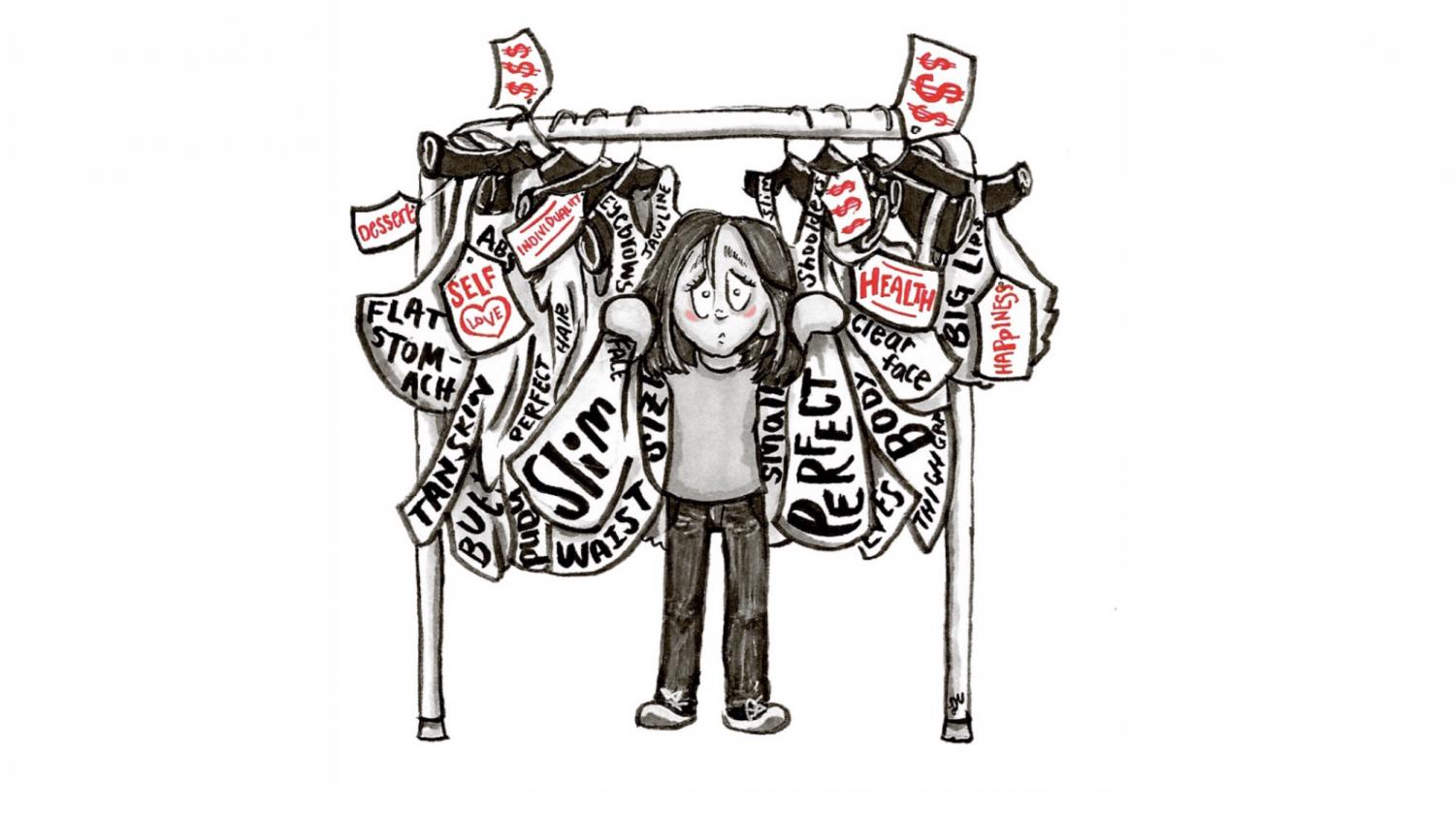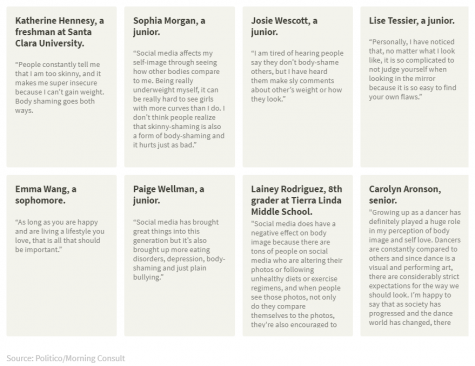
Twitter: Annawilky2020

Twitter @lexiromanowsky


December 19, 2020
Suffocating.
That’s how it feels to be a girl.
As a girl, you are continually being judged and told you aren’t good enough, and it’s only getting worse. 21st century girls are being taught they can’t love themselves, especially their bodies. It is time society stops pushing the unattainable image of the perfect girl.
Social media is so intertwined with body-image that it becomes toxic. Social media has created new standards for everyone. With apps like Photoshop, girls are able to contort their body to look like whatever they want.
This issue originally started with Instagram but recently has taken over the app TikTok. There have been challenges going around the app that, according to many of its users, shame people who don’t have the “perfect body.” Some examples are the “hourglass challenge,” where people would pull their shirts back to see if they have an hourglass figure, or the “chubby cheeks” trend, where people could stretch their face or bodies out with a filter and then turn the filter off and have a “normal” face again.
While these videos of the trends could be harmless, the reactions of many users have made such trends toxic. Specifically, there was a trend on TikTok where people would post what they eat in a day. Essentially, this was just an enticing way for people to show their recipes. However, the trend quickly turned into people commenting things such as “I am never eating again” or “you are too skinny to be eating that little”.
Overall, TikTok is one of many apps where people can comment on whatever they want, without repercussions. These videos and comments are often harmful to body-image and can cause people to stop eating or eat more to obtain the “perfect body.”
“Social media is a new avenue for individuals to engage in maladaptive body comparison processes, creating a need for health communication and behavior change interventions that address this issue, especially among vulnerable populations,” said Deanna Puglia, a specialist in media and journalism.
Another thing that has gone viral on TikTok body-shaming. Around 94% of teenage girls have been body-shamed.
Many of these body-shaming videos are men saying that women don’t have the right body to be dancing or that they can’t wear certain tops because of how they look. Many mainstream TikTok stars speak out against this, such as Charli D’amelio and Sienna Mae. Even so, people commenting negative things on each others’ posts is uncalled for and relentless.
Social media isn’t the only form of body-shaming that is fabricated into our daily lives.
Schools do this too.
The Physical Fitness Test (PFT) is something that I noticed creates a lot of body-hatred. Specifically, the Body Mass Index (BMI) segment of the test. By judging one’s health simply by considering a student’s height and weight, the BMI test sets up an unrealistic standard for the “perfect weight.” Every few months the experts say that the “BMI is flawed.” Most of them, like the researchers from the Perelman School of Medicine, University of Pennsylvania, agree.
While the BMI is not preferred, it is stated in the PFT reference guide elaborates on why this form of testing is still used.
“The Body Mass Index is not the recommended body composition test particularly for some students with high muscle mass; however, it is available because there may be local policies limiting skinfold measurements,” the PFT reference guide states.
When students take the test, it most commonly occurs during their freshman year of high school, a time which can be difficult for many. A new national survey published by The JED Foundation found that 50% of freshmen reported feeling stressed most or all of the time.
Through the PFT, school systems put pressure on their students to be a certain weight in order to be considered “healthy.”

Society floods our lives with the unattainable image of a perfect woman.
Since middle school, I have struggled with the way I look. I believe that body-shaming is done to everyone — all genders and sizes. I can only speak on what it’s like to be a girl who’s been told for most of my life that I am bigger than I should be.
For me, I started to hate the way I looked in fifth grade. Pretty young, I know. I unintentionally surrounded myself with friends who were three times smaller than I was. Back then, it didn’t matter what my friends looked like compared to me because we were just focused on getting the next rainbow loom bracelet.
In the early months of my fifth-grade year, one of my friends started to make fun of me for how my legs looked. She said I looked like a boy and that my legs were too fat to be her friend. Being only 10-years-old, it didn’t bug me too much because I didn’t really understand what it meant. Of course, I went home to my mom and asked what my friend was talking about. That was when my mom reassured me that the way I looked was perfectly normal and that everyone has different genetics. She said that I shouldn’t listen to what other people say. The next time my friend made fun of me, I repeated what my mom had told me, and that was the end of that, or so I thought.
In middle school, I always tried to hide my legs the best I could. I would wear baggy pants or long t-shirts so no-one would see what my legs really looked like. This self-consciousness continued all the way into high school. I thought high school would be the perfect time to get away from the people who made me feel bad about myself, and I could have a fresh start.
I remember freshman year; girls would cry in the bathroom because they were stressed they wouldn’t pass the physical education BMI test. That is when I truly became aware that so many other people were struggling with their body-image. Since then, so many more girls I met became obsessed with how they looked.
Looking back, I think sophomore year is when most people I knew were struggling with body-image. I would get calls from my friends, and they would be crying about how they would never look like some girl they saw on Instagram, or how no one would like them unless they had a bigger butt or a smaller waist. As a girl, it is so tiring always having to try and please society’s standards of what a woman should be.
In the middle of last year, during the homecoming football game, I heard a boy tell his friend, “Dance team isn’t that good. They are all just fat and ugly anyway.”
Yes, someone actually said that. In front of the team. In front of my team.
There are plenty of examples of when people at school body-shame others just because they can or to make their friends laugh. It is comments like these that make girls try and be someone they aren’t, to try and please someone they barely know.
Later on in my sophomore year, I began to eat very little to try and lose weight.
That was a horrible idea.
I was unhappy all the time and still hated the way I looked. I realized something needed to change, so I took action.
I began to do what made me feel good, like exercising and eating foods that were beneficial to my health. I also took time to myself and realized that I will never be able to control what other people will think of me, so I should appreciate the beauty in everything. I didn’t surround myself with toxic people or try and change myself in order to look better for someone else.
I know nothing can change overnight, but taking little steps towards self-love is all that matters.
21st century girls will no longer be suffocated by society.

